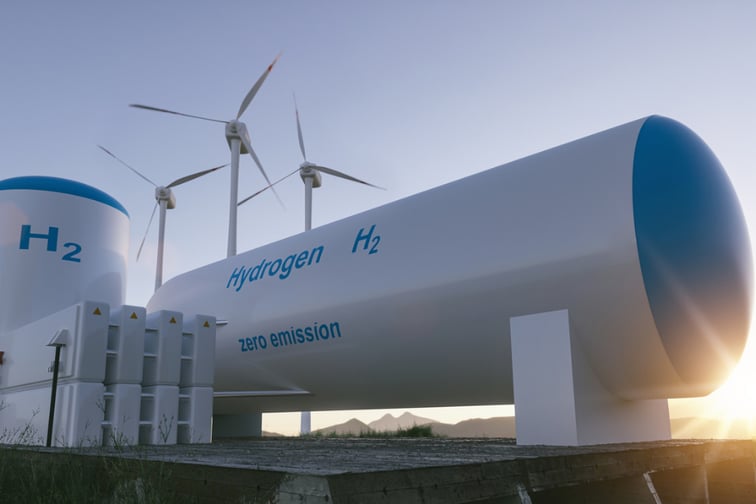

The following article is provided by HDI Global SE.
Hydrogen is emerging as a new energy alternative and the advances in technology are positioning Australia as a real contender in the global race to zero emissions. As international interest accelerates, the pressure is on the insurance industry to keep up.
Industrial insurer HDI Global SE sees significant potential for hydrogen to be a cornerstone of a greener future, especially as a sustainable, clean power source. “We think the hype is justified, although there is still much work to be done to be able to safely and efficiently produce and transport hydrogen in commercially viable quantities,” said Haris Michaels, underwriting manager engineering for Australasia at HDI Global SE.
Hydrogen could be reshaping the geography of energy trade according to the International Renewable Energy Agency (IRENA). Driven by climate urgency and countries’ commitments to net zero, IRENA estimates that hydrogen could cover up to 12% of global energy use by 2050. “Hydrogen is clearly riding on the renewable energy revolution with green hydrogen emerging as a game changer for achieving climate neutrality without compromising industrial growth and social development,” said Francesco La Camera, director-general of IRENA.
Whilst there is a lot of optimism about the future potential for hydrogen, production, transport and storage are not without risk. “Although we typically see a high level of safety built into hydrogen projects, the biggest challenge we face is to open the eyes of project owners that legal compliance does not necessarily mean safety in all aspects,” said Philipp Glanz, risk engineering manager Asia-Pacific for HDI Global SE.
A one-product-fits-all approach does not necessarily work with hydrogen and HDI Global has found that the best approach is to work with clients on “custom solutions for risk determination and mitigation in this new field”, as Dr. Natalja Wendt, a risk engineer from HDI Risk Consulting (HRC) Engineering, explained. “Facing the needs of our clients, HRC has combined its knowledge in production, transport and use of hydrogen in a group of global experts.”
In recent weeks, Germany has accelerated international negotiations to buy hydrogen from Australia as it needs to reduce its energy dependence from Russia. In addition, a first declaration of intent to supply hydrogen was signed – between the Australian company Fortescue Future Industries and the German Covestro AG. However, during a recent visit by German delegation from business, science and politics, German Federal Minister for Science and Research, Bettina Stark-Watzinger said; “Business must move from declarations of intent to joint projects and facilities that are as large as possible.”
“The trip to Australia was a worthwhile investment in Germany's energy future,” said Ms Stark-Watzinger. She declared a hydrogen supply partnership with Australia to be a realistic possibility. “It is not a distant dream of the future: Australian sunshine and wind can be bottled and shipped with the help of German cutting-edge technology,” she said. “We have a great opportunity to be pioneers here. To do this, we now have to move from conceptualizing to making. As the federal government, we must quickly revise the national hydrogen strategy and undertake the certification of green hydrogen.”
Given the distance between Australia and Germany, some have questioned if a German-Australian hydrogen partnership really makes sense. However, calculations show that transport costs are less than 15% of the total cost when acquiring hydrogen. Currently hydrogen is transported in bulk liquid form similar to liquefied natural gas (LNG). The main mode of transport is cryogenic road tankers that carry the liquified hydrogen.
As global demand increases and Australia’s energy transition continues, HDI Global SE encourages the sector to consider insurance early. “At this stage, production is limited to small quantities, with transport limited to relatively short overland distances in purpose-built containers on trailers,” said Mr Michaels. “Being able to safely and economically scale up production and transport is the key to being able to unlock its potential to export markets.”
Climate change is this century’s challenge and hydrogen offers real potential as a zero emissions energy alternative. With 103 Australian hydrogen projects with a value of $163.2 billion in the pipeline according to the Clean Energy Council, the sector is attracting significant investment. However, the insurance industry and the sector need to work together to develop measurable and helpful risk improvement measures that will satisfy the needs of hydrogen projects and operations.
Forward-looking statements
This news release may include forward-looking statements which are based on certain assumptions, expectations and opinions of the management of Talanx AG and HDI Global SE. These statements are, therefore, subject to certain known or unknown risks and uncertainties. A variety of factors, many of which are beyond Talanx AG’s and HDI Global SE’s control, affect our business activities, business strategy, results, performance and achievements. Should one or more of these factors or risks or uncertainties materialize, actual results, performance or achievements of Talanx AG and HDI Global SE may vary materially from those expressed or implied in the relevant forward-looking statement. Talanx AG and HDI Global SE do not guarantee that the assumptions underlying such forward-looking statements are free from errors nor do Talanx AG and HDI Global SE accept any responsibility for the actual occurrence of the forecasted developments. Talanx AG and HDI Global SE neither intend, nor assume any obligation, to update or revise these forward-looking statements in light of developments which differ from those anticipated.
